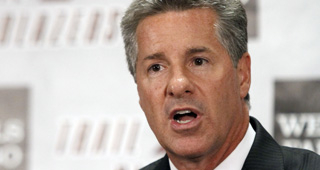During Neil Olshey’s tenure in the Los Angeles Clippers’ front office, the franchise drafted Blake Griffin, traded for Chris Paul, and matched an offer by the Golden State Warriors to re-sign DeAndre Jordan. Those three players are the only members of the Clippers’ current roster that were acquired under Olshey’s guidance before he left the team in 2012 to become the general manager of the Portland Trail Blazers. Since then the Clippers have failed to successfully build a roster around Paul, Griffin, and Jordan. Meanwhile, Portland is full of the type of players the Clippers should have been targeting.
To put it more accurately, the Clippers have been shuffling a roster with finished products while the Blazers have invested in development.
The Clippers have obviously had terrible injury luck this postseason, and losing Paul and Griffin sort of precludes the blame of a potential early exit from landing on anyone but the Basketball Gods. But even at full health the Clippers were far from a favorite this year, and a core that includes three top-tier talents has still yet to make the conference finals. The growing consensus is that it may never happen.
It’s not that the Clippers have to worry about a rapid, age-related decline from their three superstars—they aren’t that old on average—but they continue to carry the heavy burden of an incompetent supporting cast. With the exception of J.J. Redick, who is a fine complementary player, Doc Rivers has continuously failed to fill out his roster.
Austin Rivers, Paul Pierce, Lance Stephenson, Josh Smith, Jeff Green, Wesley Johnson and Pablo Prigioni are all players Rivers believed would contribute to the Clippers at a championship level. Having a hunch that one of those guys might be a good fit would have been defensible. Employing all of them within a season is like trying every color of M&M before realizing you’re allergic to chocolate.
Paul, Griffin, and Jordan are relatively traditional players. Unquestionably there aren’t a lot of human athletes like Griffin, but he plays one position, has limited shooting range, and is not a Draymond Green-type defender. That’s not the Clippers’ problem. Players as transcendently good as those three can demand to play specific roles. In fact, it’s important to give them a role that best utilizes their supreme talent, which the Clippers do with their stars. But when your superstars have such clearly defined roles, your supporting cast cannot afford to be one-dimensional, and that’s exactly what the majority of the Clippers are. Jamal Crawford, for example, should be celebrated as one of the most fun basketball players to ever bounce a ball, but he isn’t stopping anyone on defense. These things seem small, but the very best teams will exploit them, and the very best teams are the ones that have been knocking the Clippers out of the playoffs.
--
As sophisticated as front office decisions might seem, plenty of teams just hunt for max-contract superstars and minimum contract players who don’t have to do much to become more valuable than their contract. Most of the in-between is just filling out a roster. The Blazers carefully target players with two things in common: A.) They don’t have any glaring weaknesses and B.) They are open to and primed for development. They then proceed to invest in the development of those players
Damian Lillard may be a gunner who looks for his own shots, but he is considered a good teammate who actively roots for his teammates. He encourages players outside of the rotation and ensures them he’ll be confident playing with any of them in crunch time. Lillard, Olshey and Terry Stotts have created a specific environment. That environment seems to posit that certain players will improve 5 percent through opportunity and 5 percent through the way the coaching staff develops them. Players they are already intrigued with who improve by 10 percent are good enough to contribute to the team.
Last season, I arrived to a Blazers/Mavericks game in Dallas two hours early and sat in the front row, while six Blazers played three-on-three competitively. One of the players was current Phoenix head coach Earl Watson. Three others were CJ McCollum, Allen Crabbe, and Will Barton, all of whom were mostly out of the Blazers’ rotation at the time. The games looked fun and competitive, but every so often an assistant coach would stop the sets to lecture certain players. A season later, Barton, McCollum and Crabbe stepped into much bigger roles.
The Blazers surely aren’t the only team to have these sort of scrimmages, but the proof is evident of the way they work with their players. Gerald Henderson has spoken about the how much he values the team’s commitment to developing his game rather than treat him, as a sixth-year player, like a finished product. Henderson has become the type of wing that the Clippers need. He can hit open shots and create off the dribble while playing consistent defense. The Blazers don’t lose anything when he comes in because he does everything well. Same goes for Crabbe to a degree.
Miles Plumlee would be a terrific backup big for the Clippers because he could play alongside Jordan or Griffin. Ed Davis would hold his own on both ends of the floor and thrive with whatever minutes he could play with Paul. Meyers Leonard could stretch the floor as well as Johnson or Pierce and provide more rebounding. The Clippers gave up Al-Farouq Aminu to get Paul, but he would make life much easier on the Clippers’ stars with his energy, defense, and rebounding.
Jordan, Paul, and Griffin might be broken up as early as this offseason if the right move manifests itself. But their failures haven’t really been about those three or Rivers’ ability to coach them. There’s a nuance to getting the best out of mid-tier NBA players. The Clippers used to have a GM who knew how to do it.



